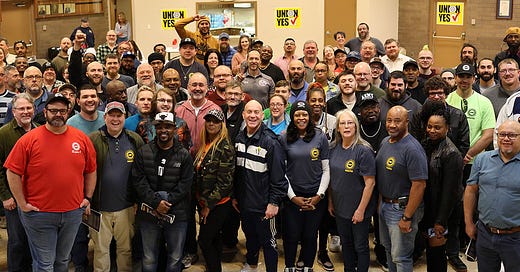The Rising of the South
Workers at the Chattanooga, Tennessee, VW plant won a landslide union representation victory, April 19. In doing so, they defied centuries of oppression and class division by the rich and powerful.
What’s more, they violated the South’s unwritten rule by uniting Black and white workers. The vote was 2628 for representation by the United Auto Workers, and 985 against. That’s a margin of 73 percent.
The Southern “aristocracy,” has fought for centuries to maintain their power, by any means necessary. That “peculiar labor,” as John C. Calhoun called slavery in 1828 was the beginning of the PR campaign to put a smiley face on the ownership and mistreatment of human beings nearly two hundred years after it began in the U.S. colonies.
After the civil war, the wealthy resorted to outright terrorism against former slaves, and those northern whites who would help them. The Ku Klux Klan was funded by the rich, while much of the dirty work, including murders, was handled by lower-income whites.
During the Ulysses S. Grant administration, union soldiers were sent to the South to suppress the violence against Blacks. The passage of discriminatory legislation against Blacks, known as Jim Crow laws, created nearly slave-like conditions for former slaves. One of the provisions called for the strict segregation of Black and white workers. Jim Crow laws continued until the civil rights movement of the 1960s. Even the Ku Klux Klan was revived in the 1920s, and again in the 1960s. Many right-wing Southerners are equally comfortable with neo-Nazi groups and the KKK.
In spite of “progress” in civil rights during the past half century, wage discrimination continues with Blacks averaging 20 percent, or more, below wages of white workers. Hence the need for a union.
Are the rich and powerful still fighting to keep workers down? Yes, they are. In a statement before the election in Chattanooga, six Southern Governors urged the workers to reject the union. The governors were: Bill Lee (Tennessee), Kay Ivey (Alabama), Brian Kemp (Georgia), Tate Reeves (Mississippi), Henry McMaster (South Carolina), and Greg Abbott (Texas).
The united victory of Black and white workers in the United Auto Workers Union election portends the possibility of a new day in the South. The election win at VW was overwhelming. It may be followed at the Mercedes non-union auto plant near Tuscaloosa, Alabama, where 5,000 workers are eligible to vote from May 13-17.
The campaign for better pay, benefits, retirement, health & safety, and workplace rights regardless of race or ethnicity is showing signs of becoming a movement. Active organizing campaigns are being waged at Hyundai in Montgomery, Alabama, and Toyota in Troy, Missouri. According to the UAW, workers at over two dozen other plants are in the midst of organizing campaigns.
The desire for unionization has been growing around the U.S. in the past few years, but the UAW’s drive represents a huge advance where multiple facilities with thousands of workers are seriously being courted by a major union. The UAW was founded in the 1930s by left-wing, shop-floor workers, like Wyndham Mortimer, Robert Travis and hundreds more in nearly every plant then making automobiles. Long-time president, Walter Reuther came along later.
In recent years, the UAW had been plagued with corruption in high places. In the early 2020s, both the current president, Gary Jones, and the previous president, Dennis Williams were sent to prison for corruption, including embezzlement.
A reform president, Shawn Fein, was elected who cleaned house, and led a powerful strike movement against the Big Three auto makers which won most of the UAW’s demands and made them the leading force in the AFL-CIO.
The prospects of organizing thousands of workers, if not millions, may be at hand if the unions follow through on their new-found militancy. But where are the other unions? The current crop of union leaders have to look to their past.
Operation Dixie
In 1946, the CIO (the militant wing of what became the AFL-CIO) voted that all its unions should join Operation Dixie, which was a campaign to focus on 12 Southern states. The plan was good, but the times were wrong. President Roosevelt had died the previous year and the Democratic Party was backing down from its New Deal program, which had brought us social security, created jobs, provided relief for the poor, and reigned in capitalist booms and busts, among other things.
Republicans won a Congressional majority in 1946 and began dismantling the New Deal. The cold war was beginning with hostility against wartime ally, the Soviet Union, and driving communists out of their jobs, particularly in unions, and in many cases, sending them to prison. This caused division, and in-fighting among unions and ultimately brought about the failure of Operation Dixie.
Something like Operation Dixie could work today. Unions are getting along together, and top union leaders are learning that they have more job security if they stand up for their members, instead of catering to the employers. The support for unions among the general public has never been stronger.
Let’s hope that the UAW is successful in its Southern organizing campaigns and that other unions follow their lead. With success, the atmosphere of the entire country could change.




